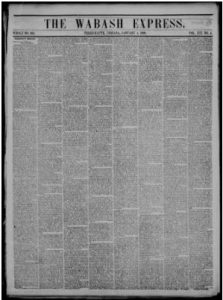
On December 13, 1841, John Dowling established a Whig weekly titled the Wabash Express in Terre Haute, Indiana, located on the banks of the Wabash River. John’s brother, Thomas Dowling, had previously owned the Wabash Courier, and one of the terms of sale prohibited Thomas from establishing another Terre Haute newspaper for five years. Thomas recruited his brother to establish the Express in his stead to circumvent the provision. John Dowling sold the Wabash Express in 1845 to David S. Danaldson. In January 1851, Danaldson issued a short-lived daily edition, the Daily Wabash Express. John B. L. Soule purchased the Express in November 1853 and edited the paper until June 28, 1854. Some sources claim that it was Soule who coined the famous phrase, “Go west young man,” while editing the paper.

Robert N. Hudson began operating the Express in September 1855. Hudson also acquired the press of the Know Nothing supporting Terre Haute Daily American around this time. He established a permanent daily, the Daily Express, in addition to continuing the paper’s weekly edition. In 1857, Hudson acquired the Wabash Courier and merged it into the Express’s operations as well. “Devoted to the Whig Policy” continued to appear below the Express’s title well into 1859, even though the Whig Party had collapsed several years before. In 1856, the Express endorsed candidates of the People’s Party, a forerunner of the Republican Party in Indiana.
Charles Cruft purchased the Wabash Express in 1861 and owned it throughout the Civil War, even while serving as a brigadier general in the Union Army. In 1867, Cruft altered the title to the Terre-Haute Daily Express. Circulations for the weekly and daily editions of the Express neared 1,000 in 1869. Cruft sold the paper in 1872 to the Express Printing Company. From 1875-1879, the publishers operated the paper as a Greenback Party organ and retitled it the Terre Haute Dollar Express. They also started a Sunday edition in 1878. In August 1879, William R. McKeen acquired the paper, changing its name back to the Terre Haute Express. He sold it in May 1882, and in that same year Mary Hannah Krout briefly served as the editor of the Express, likely making her among the first female editors of an Indiana newspaper. In 1883, George M. Allen, the new owner, added a second daily edition published every evening, which was short lived. Allen also instituted other changes: the weekly edition increased to eight pages around 1888, the daily edition expanded to eight pages during the 1890s, and the weekly edition changed to a semi-weekly in 1897. Allen sold the Terre Haute Express in March 1899 to a stock company led by McKeen. Daily circulation reached 3,000 copies in 1900. After a nearly 62-year run, the last issue of the Express appeared on April 29, 1903. The non-partisan Terre Haute Morning Star succeeded the Express and until late 1904 carried its name on the masthead as the Terre Haute Morning Star and Express.
